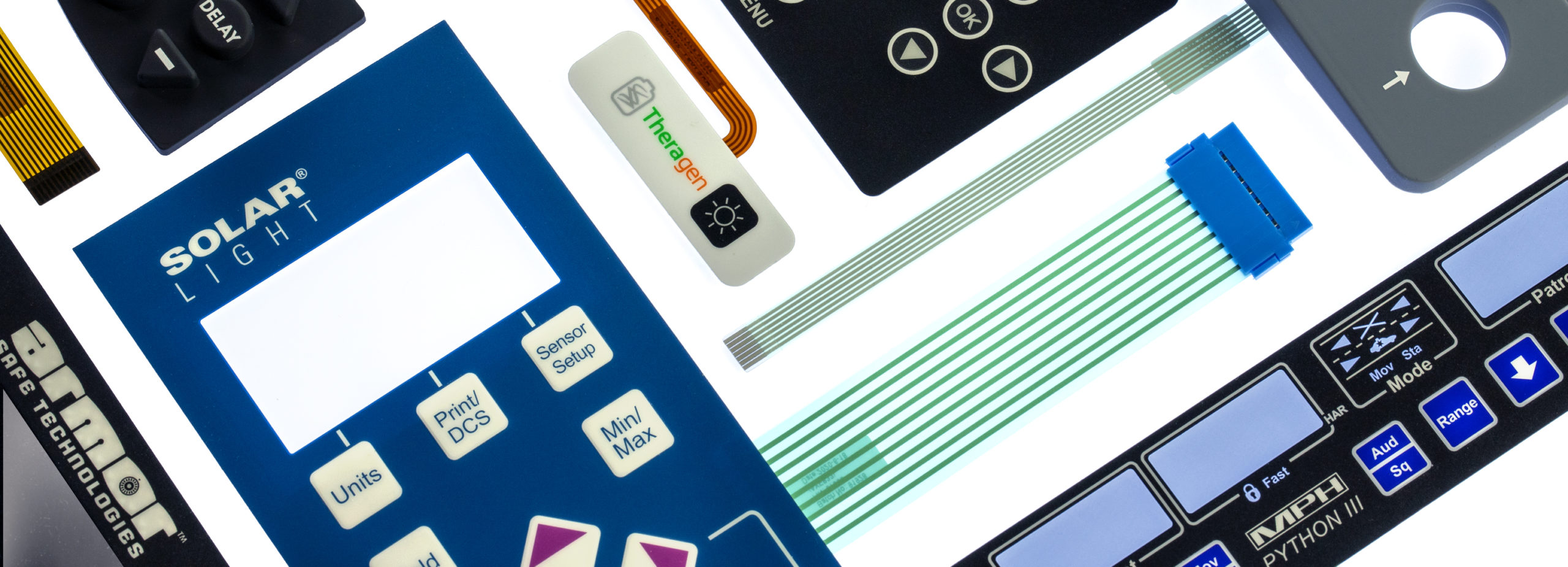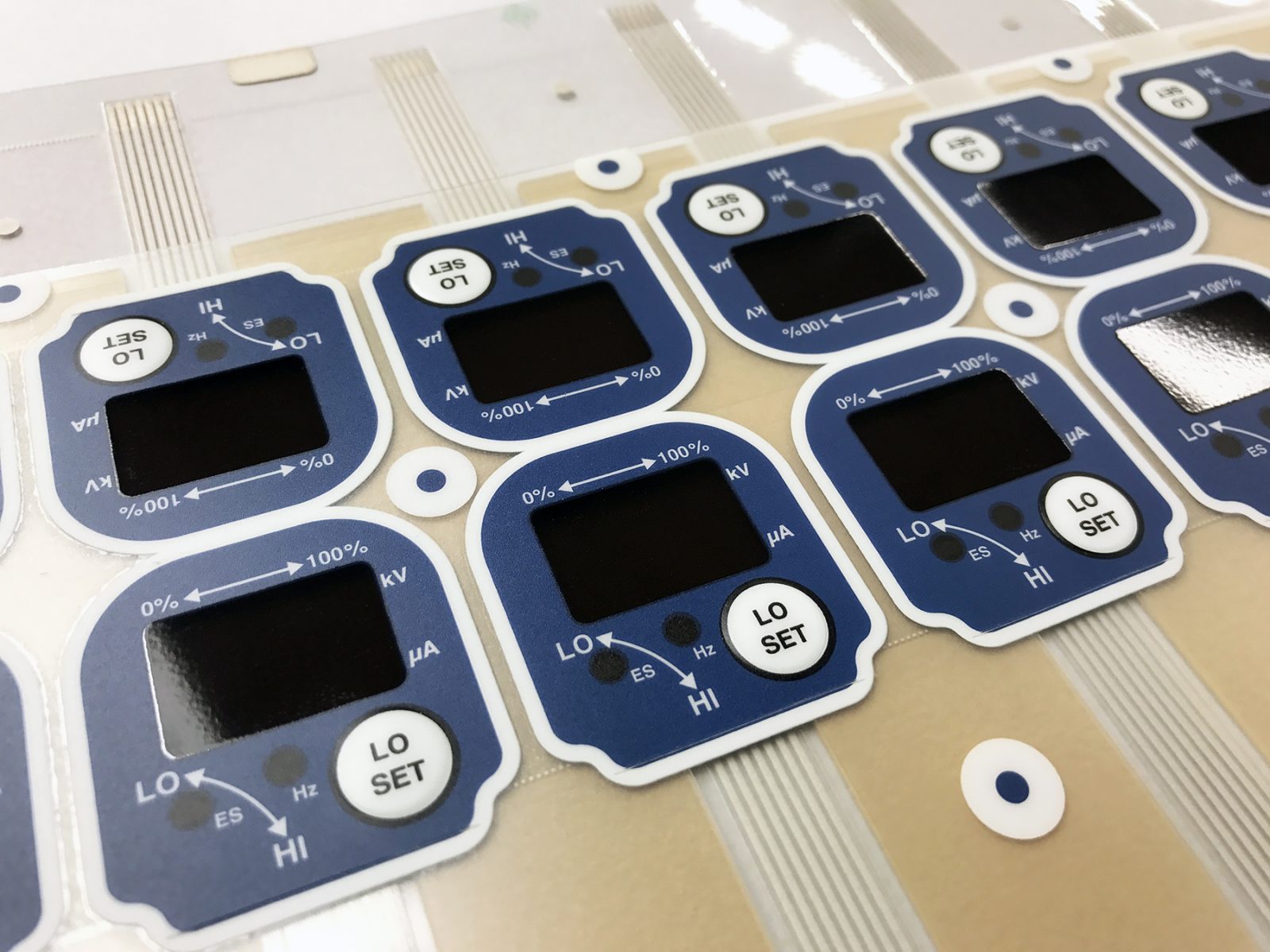Unique Designs by a Professional Membrane Switch Manufacturer
Exploring the Production Process of Membrane Switch for Numerous Industries
The production process of Membrane switches is a complex endeavor that requires accuracy and focus to detail. From picking appropriate products to implementing extensive quality assurance actions, each action plays an important role in making sure capability. Numerous markets, consisting of automobile and medical, count on these parts for their unique applications. Comprehending the ins and outs of this procedure reveals significant insights right into just how these switches are generated and their effect across varied markets.
Understanding Membrane Switches: An Introduction

Key Products Utilized in Membrane Switch Production
In Membrane switch manufacturing, the selection of vital materials substantially influences performance and durability. Conductive materials, adhesives, and finishes play important roles, while substrate option affects total efficiency and reliability. Recognizing these components is crucial for enhancing the layout and manufacturing of Membrane buttons.
Conductive Products Summary
Conductive materials play an essential role in the performance of Membrane buttons, making certain reputable electrical connections within the gadget. Commonly utilized products include silver, copper, and carbon-based inks, each offering unique benefits. Silver is preferred for its high conductivity and toughness, making it perfect for applications calling for robust performance. Copper, while a little less conductive than silver, is an economical option often utilized in published circuits. Carbon-based inks provide a flexible alternative, suitable for applications where adaptability and reduced expenses are focused on, although they have actually lower conductivity compared to metal options. The choice of conductive materials directly affects the total reliability, life-span, and efficiency of the Membrane button, making it a crucial factor to consider in the production process.
Adhesives and Coatings
Finishings and adhesives are essential parts in the production of Membrane switches, providing important bonding and safety residential or commercial properties. These materials guarantee that numerous layers of the switch, including visuals overlays and wiring, adhere securely to one an additional, enhancing toughness and performance. Frequently utilized adhesives include pressure-sensitive adhesives (PSAs) and epoxy-based formulas, which use strong bond and resilience. Coatings, such as polyurethane or acrylic, offer to secure against environmental variables, including wetness, abrasion, and chemicals. In addition, layers can improve tactile feedback and aesthetic charm, contributing to the total customer experience. The choice of appropriate adhesives and layers is important for enhancing performance and longevity in diverse applications throughout different industries, guaranteeing that Membrane switches over satisfy specific functional needs.
Substratum Option Aspects
Substrate selection plays an essential role in the production of Membrane switches, as it significantly influences their overall efficiency and resilience. Trick products such as polyester, polycarbonate, and flexible printed motherboard (FPCBs) are commonly used for their distinct homes. Polyester is favored for its cost-effectiveness and resistance to abrasion, making it suitable for applications with high wear. Polycarbonate offers superior quality and impact resistance, suitable for environments needing high presence. FPCBs offer boosted flexibility and are commonly utilized in complex styles. The selection of substrate likewise influences factors like thermal stability, chemical resistance, and simplicity of printing. Inevitably, selecting the proper substratum is important for guaranteeing the performance and longevity of Membrane changes throughout various industries.
The Layout Refine of Membrane Changes
The layout process of Membrane switches is an important stage that greatly affects the capability and visual appeals of the last item - membrane switch manufacturer. It begins with specifying the particular demands of the application, consisting of measurements, switch format, and tactile comments choices. Designers need to take into consideration individual communication, making sure that the button is instinctive and accessible.Next, materials are chosen based upon durability, versatility, and ecological resistance. The assimilation of graphics and branding aspects is likewise vital, as it improves aesthetic appeal and communication. Prototyping permits repetitive screening, enabling adjustments based on user responses and efficiency evaluations.Additionally, the layout should account for the electrical components, such as circuits and adapters, guaranteeing reliability and ease of use. Eventually, a successful style harmonizes functionality, appearances, and customer experience, leading the way for efficient production and long-lasting performance in various sectors
Printing Techniques for Membrane Changes
The printing methods made use of in Membrane switch production Read Full Report play an essential function in determining the final item's high quality and functionality. Display printing supplies benefits such as longevity and vivid shade application, while electronic printing advancements offer adaptability and accuracy in design. Recognizing these techniques can significantly influence the general efficiency of Membrane buttons in various applications.
Screen Printing Benefits
Countless benefits make screen publishing a preferred strategy for creating Membrane switches. This approach enables for top quality, detailed styles and vivid colors, which are important for user interface applications. Display printing is especially reliable for applying thick ink layers, boosting sturdiness and tactile comments. Furthermore, it uses exceptional adhesion to different substratums, making certain durability in requiring atmospheres. The procedure is affordable for big production runs, as it minimizes setup time and waste. Screen printing supports a wide range of inks, including specialized and UV-curable alternatives, making it possible for convenience in design. Its ability to produce regular outcomes across numerous devices makes it a trustworthy selection for suppliers aiming for high quality and efficiency in Membrane switch production.
Digital Printing Innovations

Improvements in digital printing modern technology are transforming the manufacturing of Membrane switches, supplying makers ingenious solutions that enhance layout versatility and effectiveness. Digital printing permits high-resolution graphics and elaborate styles, allowing custom-made branding and functionality without the constraints of typical techniques. This technique minimizes configuration times and costs, promoting much shorter manufacturing runs and marginal waste, making it excellent for businesses with differing needs. In addition, innovations in ink formulas provide much better durability and bond, ensuring longevity in different environments. As industries progressively seek complex and tailored designs, electronic printing stands out as an essential strategy, setting a new criterion in Membrane switch production. The assimilation of these developments positions makers to meet advancing market requires effectively.
Setting up and Layering of Membrane Switch Elements
Careful assembly and layering of Membrane switch parts are vital to ensuring functionality and resilience. This process begins with the precise alignment of various layers, consisting of the graphic overlay, glue, circuit layer, and backing material. Each element must be meticulously placed to maintain electrical stability and customer interface responsiveness.During setting up, conductive traces are put on the circuit layer, typically made from materials like polyester or polycarbonate. This layer is crucial, as it beams when pressure is applied. The adhesive used for bonding these layers is also chosen for its capability to withstand environmental anxieties while maintaining a safe bond.Heat and stress are frequently used throughout the assembly process to ascertain that the layers stick correctly without compromising the functionality of the switch. Focus is offered to the edge securing to secure against wetness and contaminants, securing the durability of the Membrane switch in various commercial applications.
Top Quality Control Procedures in Membrane Switch Manufacturing
Quality assurance procedures play a necessary role in ensuring the integrity and efficiency of Membrane switches complying with the setting up and layering of their elements. In this hyperlink the production procedure, numerous key examinations are performed to promote top quality requirements. These consist of visual examinations for problems in printing and glue application, as well as practical examinations to validate the responsiveness of each her explanation switch.Additionally, environmental screening is performed to assess the buttons' longevity versus temperature variations and humidity exposure. Suppliers frequently implement statistical procedure control (copyright) techniques to keep an eye on production consistency, enabling early discovery of anomalies.Furthermore, traceability systems are established to track parts and products, making certain liability and facilitating remembers if necessary. Calibration of devices and adherence to sector requirements are additionally important to maintaining item stability. Collectively, these quality assurance procedures guard the performance of Membrane switches across various applications, inevitably enhancing consumer complete satisfaction.
Applications of Membrane Changes Throughout Different Industries
Membrane switches are made use of throughout a diverse array of industries, showcasing their versatility and adaptability. In the clinical field, they give dependable and waterproof user interfaces for gadgets such as analysis tools and mixture pumps, making sure health and simplicity of usage. The automobile industry uses Membrane switches for control panel controls, allowing seamless interaction in between the vehicle driver and vehicle systems.In customer electronic devices, these switches are discovered in appliances and handheld devices, supplying a smooth, contemporary aesthetic while enhancing functionality. Industrial applications additionally take advantage of Membrane switches over for machinery control board, where sturdiness and resistance to severe conditions are essential.Furthermore, the aerospace and protection sectors utilize Membrane buttons for cockpit instrumentation and interaction systems, focusing on reliability and efficiency under extreme problems. Generally, Membrane buttons play a crucial duty in boosting the customer experience and operational efficiency throughout different domain names.
Frequently Asked Concerns
For how long Does It Require To Produce a Membrane Layer Switch?
The production time for a membrane layer switch typically ranges from a couple of days to several weeks - membrane switch manufacturer. Aspects influencing this duration consist of layout complexity, material schedule, and production volume, all influencing the overall timeline substantially
What Is the Common Life Expectancy of a Membrane Layer Switch?
The common life expectancy of a membrane layer button typically ranges from 1 to 5 million actuations, relying on aspects such as material quality, environmental problems, and use regularity, greatly affecting longevity and overall performance.
Can Membrane Changes Be Personalized for Details Applications?
Membrane buttons can indeed be customized for particular applications. Their style versatility enables changes in size, shape, colors, and graphics, making sure compatibility with distinct needs throughout numerous sectors and boosting capability and customer experience.

Are Membrane Switches Over Eco Friendly?
The ecological effect of Membrane switches over varies. Some materials utilized might not be green, while innovations in producing procedures are increasingly concentrating on sustainability, intending to decrease waste and advertise recyclable parts in their production.
What Are the Typical Failing Settings of Membrane Buttons?
Common failing settings of Membrane switches include delamination, sticky failing, damage from usage, wetness access, and electric failures. These issues can considerably influence performance, performance, and life-span in various applications across various sectors. Membrane switches can be customized to fit particular style needs, such as shape, performance, and dimension, making them very adaptable.The construction commonly involves multiple layers, including a graphic overlay, adhesive, and a circuit layer, which work together to create a smooth individual experience. In Membrane button manufacturing, the choice of essential products greatly influences capability and durability. The automotive industry utilizes Membrane buttons for control panel controls, allowing smooth interaction in between the driver and vehicle systems.In consumer electronic devices, these buttons are discovered in devices and handheld devices, supplying a sleek, modern aesthetic while boosting performance. Industrial applications also utilize Membrane switches over for machinery control panels, where toughness and resistance to extreme conditions are essential.Furthermore, the aerospace and defense sectors make use of Membrane switches for cabin instrumentation and interaction systems, prioritizing reliability and performance under severe problems. Membrane switches can undoubtedly be tailored for certain applications.